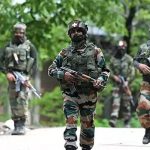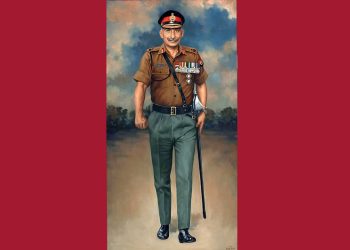“Yatha buddhiḥ tatha saktiḥ – As is the intellect, so is the power”
Abstract
In contemporary times, conflict is changing and hence has become more complex. Today, battles are not just fought on land, air, or sea, but encompasses a vast domain involving the cyberspace. Alongside traditional military threats, we now face cognitive warfare and disinformation campaigns from our enemies. In these situations, the human mind is the most crucial battleground, whether in war or peace.
Both state and non-state actors now use artificial intelligence, coordinated disinformation, and psychological operations to influence campaigns. These efforts aim to weaken national unity, reduce trust in institutions, and lower operational effectiveness, often without any direct conflict. This poses a serious threat to national security.
This article endeavours to show why the ‘Primacy of the Mind’ matters. Today, digital platforms can significantly influence our behaviour and make decision making more tedious and chaotic process. Hence, India needs a strong national strategy to improve cognitive security and protect its people both in peace and in conflict.
Introduction
In divergence from the past, the strategic landscape in the present arena of war has extended far beyond traditional frontlines as more exposure to online connectivity created a battlespace in the human mind.
This unprecedented form of warfare is not aimed at destroying physical assets or neutralising combatants, but to influence, disrupt, or control how humans think and respond to reality.
In August 2025, India’s telecom sector grew, reaching 1,086.18 million active mobile subscribers—about 93% of the total wireless users. This widespread connectivity can greatly influence India’s diverse population.
The Development of Cognitive Warfare: Going Beyond Kinetic
Cognitive warfare is not a new idea in strategy. Ancient Indian mythology gives many examples wherein gods, kings, and sages used deceit, psychological influence, and narrative control to win without physical force. The following are the two examples:
- In the Ramayana, there are instances of the enemy’s psychological decline. For example, when Lord Hanuman first travelled to Lanka to find Mother Sita, he warned Ravana to accept defeat at the hands of Sri Ram or face destruction.
- Similarly, Shri Krishna guided the Pandavas in the Mahabharata by influencing their emotions and bolstering their mental fortitude for battle.
The above examples show that the fight to control ideas, opinions, and morale has a long history in India. Thinkers like Kautilya emphasised the need to shape perception even before physical conflict began.
Defining the Threat Landscape
Cognitive warfare now uses digital systems and neuroscience to shape perception and affect judgement, making cognition a contested area. With algorithmic design and behavioural science, influence can turn the human mind into a battlefield. The false impression of reality
- There is a saying, “If one repeats a lie often, people believe it is the truth”.
- Pak used that as a premise to fabricate a lie during “Op Sindoor.”
- An example of this illusion is Pakistan’s belief in its fictitious victory despite the destruction of its military resources, manpower, and infrastructure.
Disinformation
Disinformation, also known as fake news, refers to communications designed to mislead, often by presenting false information or distorting the truth.
Information Influence Operations
It is also referred to as influence operations, information operations, and information warfare—involves gathering tactical intelligence about an opponent and disseminating propaganda to gain a competitive advantage.
India’s Susceptibility to Misinformation and Cognitive Warfare
- Social Diversity. Ethnic, linguistic, caste, and religious distinctions are often exploited and abused.
- Digital Expansion. False information spreads quickly among internet users.
- Democratic openness. It is a strength, but it also makes negative narratives.
- Targeting Armed Forces. The enemy’s targeted narrative can lead to decision-making, create uncertainty, and lower troop morale.
Times Ahead
In the future, narratives may become more important than weapons. Technologies like deepfakes and artificial intelligence not only spread disinformation but also make it harder to detect.
Thus, cognitive warfare occurs both in peace and in war, quietly working in the mind. In the future, the human mind will be the final battleground.
National Strategy for Cognitive Dominance
- Fundamental Body. Establish a central body responsible for executing tasks pertinent to Narrative warfare.
- Whole-of-Nation Approach and Indigenisation in AI Development. Involve the private sector, media, academia, and civil society.
- Hands-on Narrative Shaping and Internet Literacy. Put in place national initiatives to enhance online literacy.
- Empowering Journalism. Funding fact-based reporting to maintain public trust.
Tools and Tactics Used by Adversaries
- Social Media Manipulation. Bots, trolls, fake accounts.
- Deepfakes & Visual Misinformation. AI-generated media to distort facts.
- Narrative Framing. Stories undermining democratic legitimacy.
Lessons Learnt from the Past
India is highly vulnerable because of its democratic system, diverse society, and widespread digital infrastructure. The following examples show the growing impact and threat of disinformation and cognitive campaigns.
- In the Galwan and Balakot incidents (February 2019), inflated claims of Indian losses were dispersed online. One-sided promotional videos, often featuring real footage, that undermined military capabilities were seen during heightened times.
- During the COVID-19 pandemic (2020–2021), misinformation about vaccine safety weakened community health protocols and eroded trust in authorities.
- Damage incurred by disinformation campaigns at the global level by countries like Taiwan, Ukraine, etc.
The above examples show how important it is to recognise and stop disinformation and cognitive battles. For instance, during ‘Operation Sindoor’, much of the military’s effort was devoted to counter media disinformation.
Real Time Lessons
- Experts have defined ‘Operation Sindoor’ as a model case of cognitive warfare, representing how narrative can affect strategic dynamics and public perception simultaneously.
- The flow of information warfare, fact-checking, etc. during Operation Sindoor was such that experts have called it a “textbook example” of cognitive warfare.
Conclusion
Today, cognitive safety is as important as national security. India’s adversaries now understand that controlling the narrative is just as powerful as military strength. Hence, India can turn its weaknesses into strengths by building cognitive resilience through education and knowledge.













